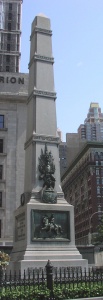
- Artist: James Goodwin Batterson
- Dedicated: 1857
- Medium & size: granite obelisk, 51 feet tall, with inscriptions and bronze reliefs
- Location: north end of the triangle formed by Fifth Avenue, Broadway, and 24th Street (just west of Madison Square Park). Subway: R to 23rd St., F or V to 23rd St., 6 to 23rd St.
About the sculpture
At Fifth Avenue and 25th Street, General Worth charges into battle on his rearing horse. He turns to look at us, which draws us into the scene and also shows us the face of the man reputed to be the handsomest in the army. Judging from the sparse plants beneath the horse’s hooves, Worth is probably in Mexico, perhaps at the Battle of Monterey for which he won his greatest fame. (See below.)
Why don’t you recall this dramatic work just opposite Madison Square Park?
Because it’s not a life-size sculpture in the round; it’s a relief only a few feet square.
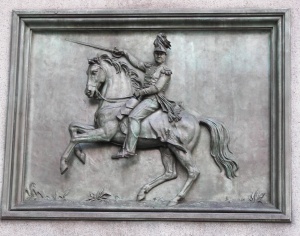
In the 1850s, life-size or over-life-size sculpture was new and still relatively rare in the United States. Henry Kirke Brown’s equestrian George Washington at Union Square (see also Outdoor Monuments of Manhattan Chapter 13) was the first large-scale bronze erected outdoors in New York in the half-century following the Revolutionary War. It was dedicated only a year before the Worth Monument.
Despite the fact that Worth is shown only on a rather small relief, his monument is impressive. The relief and other decorative elements appear on an obelisk, a form used in Egypt four millennia ago to honor the gods at temple entrances. Later the obelisk became a common memorial form, as in the Washington Monument in Washington, D.C., and Alexander Hamilton’s grave at Trinity Church, Manhattan.
Worth’s obelisk is 51 feet tall, and so heavy that city officials forbade its placement on Fifth Avenue, fearing it would damage the street. James Batterson, the designer, hauled the monument to its present site in the dead of night and managed to lever it into place before officials arrived to stop him. (See Reynolds, Monuments and Masterpieces pp. 16-23.)

You might assume the place names banding the obelisk are battles in which Worth participated …except that “West Point” appears among them. The names are in fact the scenes of Worth’s greatest triumphs. For the inscriptions, see the end of this post. For Worth’s actions at West Point, see About the subject.
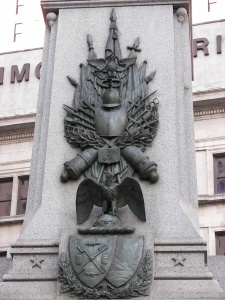
Above the relief of Worth is a group of objects arranged as a “trophy.” This one includes two cannons, swords, spears, flags, bayonets, a cuirass, a helmet, and a shield with an interlaced “N” and “5.” (I haven’t puzzled out that reference yet.) Above the trophy hovers an eagle with a snake in its mouth, a variation of the coat of arms of Mexico that must refer to Worth’s actions in the Mexican-American War. (Read more about trophies and trophy wives in this blog post.) Below the trophy is another eagle, whose feet rest on a hemisphere girdled with stars. Below the hemisphere are the coats of arms of New York City and New York State.
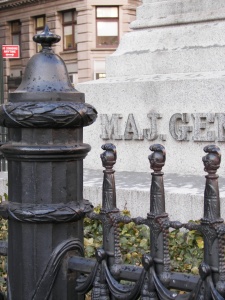
The verticals of the cast-iron fence encircling the Worth Monument replicate the dress sword awarded to Worth by his home state of New York. The sword’s gilt hilt was shaped like a knight’s plumed helmet. The replicated swords are linked by oak leaves that symbolize honor and courage.
Worth was originally buried in the Green-Wood Cemetery, Brooklyn, but on Evacuation Day (November 25th) of 1857, his coffin was escorted to the present site by the Seventy-First Regiment, with great pomp and an audience of thousands. William Jenkins Worth is technically the only person buried on New York City Parks Department property—Ulysses S. Grant and his wife are entombed rather than buried.
The elements of the Worth Monument were chosen to convey that courage, glory, and victory are worthy aims. By World War I, the messages of war memorials had dramatically changed. Gertrude Vanderbilt Whitney’s Inwood War Memorial, at Broadway at 168th St., and Karl Ilava’s 107th Infantry Memorial, at Fifth Ave. at 67th St., stress the role of lowly infantry soldiers. Both those memorials show soldiers who are determined and brave, but are nevertheless suffering and dying. For more on the changing style and content of war memorials over the past 150 years, see my book From Portraits to Puddles and read Outdoor Monuments of Manhattan Chapter 27 (Duffy).
Like war memorials, poetry can convey powerful messages about war without a word of logical argument or philosophical debate. Charles Fenno Hoffman’s “Monterey” is a paean to the excitement of battle in which General Worth played a major role.
We were not many,—we who stood
Before the iron sleet that day;
Yet many a gallant spirit would
Give half his years if but he could
Have been with us at Monterey. …
James R. Lowell, protesting the Mexican-American War in “Once to Every Man and Nation” (1845), is equally vehement about refraining from battle:
Once to every man and nation, comes the moment to decide,
In the strife of truth with falsehood, for the good or evil side;
Some great cause, some great decision, offering each the bloom or blight,
And the choice goes by forever, ‘twixt that darkness and that light. …
Which one is right? You won’t find out by studying sculpture or poetry. Art’s purpose is not to tell you what to believe or think: it’s to help you remember what’s important, once you’ve thought matters through. See my essay on Nathan Hale at City Hall (Outdoor Monuments of Manhattan Chapter 8).
About Worth and West Point
William Jenkins Worth (1794-1849) fought with distinction in the War of 1812, the Seminole Indian Wars of 1840-1842, and in the Mexican-American War, where his resolute actions at Monterey in 1846 were a turning point in the war. To contemporaries he was known as the best horseman and the handsomest man in the army. His most enduring influence, however, was on the cadets at West Point, where he was a model of precision and honor, and an inspiration for high standards of conduct and discipline.
We take for granted the existence of West Point, but for decades its establishment and survival were in doubt. In May 1783, before resigning as commander-in-chief, George Washington recommended that the United States establish a military academy. Congress, with vivid memories of British soldiers quartered in American homes (“He has kept among us, in times of peace, standing armies,” remonstrated the Declaration of Independence), responded that “standing armies in times of peace are inconsistent with the principles of republican government, dangerous to the liberties of a free people, and generally converted into destructive engines for establishing despotism” (June 1784). Congress disbanded the Continental Army and delayed raising another until Indians began to attack settlers on the frontier in the 1790s. Alexander Hamilton, serving as Washington’s second-in-command during the Quasi-War with France, submitted detailed plans for a military academy in 1799, arguing that trained military leaders would mitigate the lack of a standing army should war erupt. Only in 1802 was the academy funded. Even then was not an immediate success. When the United States stumbled into the War of 1812, only about a hundred West Point graduates were available for service. In 1813, Congress refused to grant operating funds for the United States Military Academy.
The turn-around for West Point came under Sylvanus Thayer, a brilliant West Point graduate of 1808. Appointed superintendent of the Academy by President Monroe in 1817, Thayer set out to revamp the curriculum, modeling it after that of France’s famed Ecole Polytechnique. Experts hired from across the United States and Europe taught principles, showed illustrative examples, and required cadets to demonstrate daily their grasp of a subject. The best students were encouraged to advance to studies far beyond that of the standard curriculum. Henceforward graduates of West Point knew not just how to ride a horse bravely into battle, but basics of engineering, tactics, and strategy, as well as such practical matters as keeping track of men and materials.
From 1820 to 1828 William Jenkins Worth, then a brevet major, was commandant of cadets and instructor in tactics at West Point. His book on tactics remained required reading for generations of cadets.
No fewer than 523 West Point graduates were initially involved in the Mexican-American War, including most of the officers serving under Brigadier General Zachary Taylor. Worth, who missed the first two major battles of the Mexican-American War, later wrote:
Amid all my anguish and wreck of heart I find some consolation in what I hear all around me, “that if he were not here in person he was in spirit. His discipline and inculcations were everywhere manifest.” (New York Times 7/16/1916)
Inscriptions, reliefs and comments on the Worth Monument
The sites of Worth’s principal achievements are inscribed on the sides of the monument.
- South (principal) side: Monterrey, Vera Cruz, San Antonio, City of Mexico.
- East side: Perote, Puebla, Cerro Cordo, Chapultepec.
- North side: Florida, Cippewa, Fort George, Lundy’s Lane.
- West side: Contreras, Churubusco, West Point, Molino del Rey.
The decorations and inscriptions near the base of the obelisk are as follow.
- South side: relief of General Worth on horseback, beneath a trophy (see About the sculpture).
- East side: Ducit amor patriae (“Love of country leads [me]”), with a bronze wreath above.
- North side: “Under this monument lies the body of William Jenkins Worth, born in Hudson, New York, March 1, 1794. Died in Texas May 7, 1849.” Above the inscribed plaque are the stars and stripes of the United States and an unidentified coat of arms (perhaps that of the Worth family) surmounted by an armored arm brandishing a sword. The ribbon below bears the motto Ducit amor patriae.
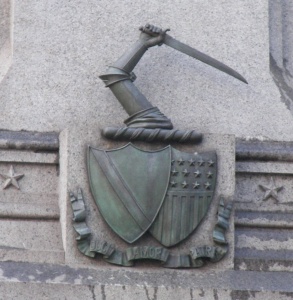
- West side: “By the corporation of the City of New York 1857. Honor the grave,” with a bronze wreath above.
Bronze coats-of-arms in front of crossed swords are repeated on the granite pillars at the corners of the fence that encloses the obelisk. Oddly, the arms on the pillars have diagonals slanting the opposite direction from the one on the relief on the northern side—a bend sinister vs. a bend, if you’re familiar with heraldic terminology.
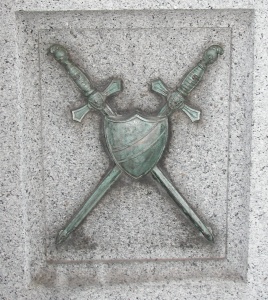
Bibliography & further reading
On the sculpture
- Lederer, Joseph. All Around the Town: A Walking Guide to Outdoor Sculpture in New York City (New York: Charles Scribner’s Sons, 1975), p. 72.
- Gayle & Cohen, The Art Commission and the Municipal Art Society Guide to Manhattan’s Outdoor Sculpture (New York: Prentice Hall, 1988), p. 104.
- Reynolds, Donald M. Monuments and Masterpieces (New York: Thames & Hudson, 1997), pp. 16-23, with photos of the Monument and the fence, and much biographical information on Batterson.
- The New York City Parks Department site includes the text of the pavement marker installed in 1995.
- SIRIS (Smithsonian Institution, Inventory of American Sculpture) IAS 76003565.
On the designer, James Batterson
- Reynolds, Donald M. Monuments and Masterpieces (New York: Thames & Hudson, 1997), pp. 16-23.
On the subject, William Jenkins Worth
- American National Biography: James M. McCaffrey, “Worth, William Jenkins,” http://www.anb.org/articles/03/03-00551.html ; American National Biography Online Feb. 2000. Includes an annotated bibliography.
- New York Times 7/16/1916: extensive quotations from Worth appear in “Never Before Published Letters of Famous General Worth, Written During the Mexican War.”
- The standard biography of Worth is Edward S. Wallace, William Jenkins Worth: Monterey’s Forgotten Hero (Southern Methodist University Press, 1953).
- Nichols, Edward J. Zach Taylor’s Little Army (Doubleday, 1963) has considerable material on Worth’s actions during the Mexican-American War.
- See also http://www.aztecclub.com/bios/worth.htm
- Worth Street in New York’s Financial District is named after William Jenkins Worth, as are Fort Worth, Texas, and Lake Worth, Florida.
On West Point
- Dupuy, R. Ernest, and Trevor N. Dupuy. Military Heritage of America (McGraw-Hill, 1956): noting that of the sixty major battles in the Civil War, fifty-five were commanded on both sides by West Point graduates. In the remaining five, a West Point graduate commanded one side only.
- Dupuy, R. Ernest. Men of West Point. The First 150 Years of the United States Military Academy (William Sloane Assoc., 1951).
More
- Want wonderfu
- In Getting More Enjoyment from Sculpture You Love, I demonstrate a method for looking at sculptures in detail, in depth, and on your own. Learn to enjoy your favorite sculptures more, and find new favorites. Available on Amazon in print and Kindle formats. More here.
- l art delivered weekly to your inbox? Check out my free Sunday Recommendations list and recurring support: details here.